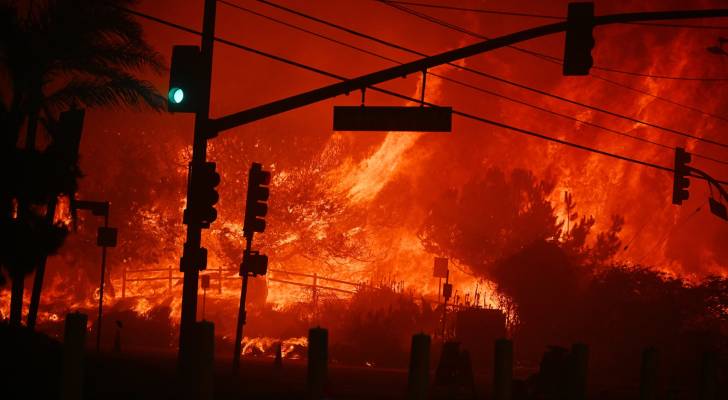Los Angeles wildfires force 130,000 to evacuate
Authorities in Hollywood Hills issued a mandatory evacuation order as wildfires swept across Los Angeles, claiming the lives of at least five people and displacing more than 130,000 residents.
The Los Angeles Fire Department warned of a "direct threat to life," prompting the legal closure of affected areas.
The fires have destroyed numerous homes, including those belonging to celebrities such as Paris Hilton and Billy Crystal.
The wildfires began Tuesday in the Pacific Palisades neighborhood near Malibu and quickly expanded to other areas north of the city.
As of 8:15 PM local time, four major fires in Palisades, Pasadena, Sylmar, and Hollywood Hills had burned through more than 27,000 acres (109 square kilometers), with none fully contained.
One fire in Acton, California was partially contained, while two others were fully controlled.
Scenes from Hollywood Hills
A fire erupted in Hollywood Hills Wednesday evening, sending thick plumes of smoke over the area, obscuring the tops of palm trees.
Residents lined the streets, some still in their pajamas, carrying bags as they fled.
Nearby roads, including the iconic Hollywood Boulevard, were congested with traffic as evacuees attempted to escape. Some drivers resorted to using the wrong side of the road in desperation.
Read more: VIDEO: Gas station explodes into flames in Beirut
Witness testimonies
Anna Waldman, a local resident, described the chaos:"When I took my dog for a walk, I immediately smelled smoke. I looked out my bedroom window and saw the fire approaching quickly," she said. "I packed everything I could carry and fled with my three dogs."
Mikayla Jackson, who was evacuated from a homeless shelter with her two-year-old son, said:"They just told us to get up and leave."
Firefighters face water supply challenges
Firefighters encountered significant challenges due to a lack of water in the affected areas.
Despite the city having three massive water reservoirs, the high intensity of the fires made it difficult to deliver water to hydrants quickly enough.
These wildfires are among the most destructive in Los Angeles’ history, highlighting how the city's water systems, designed primarily for urban use, struggle to cope with such large-scale wildfires.
Read more: Trouble in paradise? Trump shares interview criticizing Netanyahu




